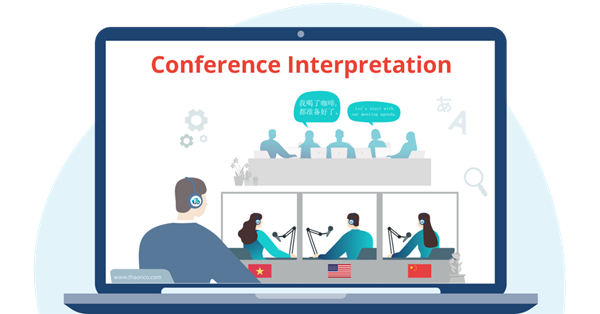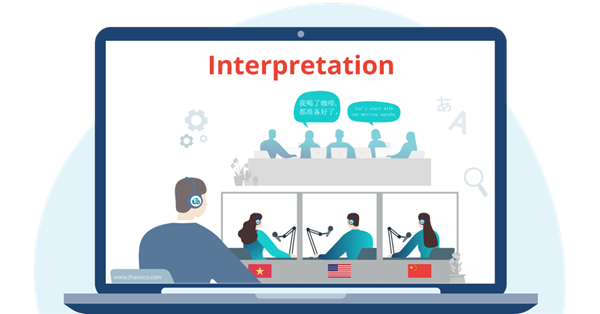Simultaneous interpreting (also known as conference interpreting) refers to multilingual interpretation that requires fluency and in-depth subject expertise. This is a specialized field that demands meticulous preparation and practice. In this article, we will delve into simultaneous interpreting with Thao & Co. and uncover the intricacies that make it more demanding than other modes of interpretation.
Simultaneous interpreting, a demanding form of language interpretation, takes place in a confined space, often employed during events, conferences, or other settings that necessitate multilingual communication.
Within the confines of a designated booth, the interpreter skillfully translates spoken words into the target language, relying on a headset or sound transmission system. With unwavering focus, they simultaneously listen to the source language and translate it into the target language, ensuring a seamless flow of information and accurate comprehension.
The advantages of simultaneous interpreting are flexibility and time-saving benefits. As information unfolds, the interpreter seamlessly translates it, enabling uninterrupted communication and a dynamic flow of ideas. The seclusion provided by the booth safeguards the confidentiality of the translation and ensures the privacy of the audience.
Various forms of simultaneous interpreting emerge from diverse usage purposes and nuanced contexts, each tailored to cater to specific communication needs. In conference settings, simultaneous interpreting serves to bridge linguistic divides, enabling seamless comprehension for a multilingual audience.
Consecutive interpreting involves the interpreter waiting for the speaker to complete a segment of speech or explanation before rendering that content into another language. The consecutive interpreter should take notes or memorize the content and then convey it in the target language.
Both of these interpretation methods are used to convey information between different languages. However, they differ in their approach and interpreting process.
Consecutive interpreting inherently involves a delay in conveying the message compared to simultaneous interpreting, as the interpreter must wait for the speaker to finish speaking before initiating the interpretation. Simultaneous interpreting, in contrast, occurs almost concurrently with the speaker’s delivery, as the interpreter listens and responds nearly instantaneously.
In an increasingly interconnected and multicultural world, effective communication across languages has become a significant challenge. However, with the emergence of simultaneous interpreting, seamless communication and information exchange between languages has become easier than ever. Let’s explore special events and activities where simultaneous interpreting is utilized.
International conferences are gatherings of people from all over the world, but language barriers often pose communication difficulties. This is where simultaneous interpreters take on the crucial role of linguistic intermediaries, providing real-time interpretation to bridge the gap between languages and cultures.
Positioned in soundproof booths, interpreters meticulously relay the speaker’s message from source to target language, fostering active participation and enhancing the cultural immersion experience.
Simultaneous interpreting has become an essential tool for facilitating communication in multilingual workshops and discussions. The interpreters sit in booths and seamlessly translate the presenters’ or speakers’ messages. Thanks to their professionalism and refined interpreting skills, ideas and messages transcend language barriers, fostering cohesion and profound understanding.

In the multilingual setting of an international court, simultaneous interpretation services are paramount to ensuring fair and equitable proceedings for parties from diverse linguistic backgrounds. Interpreters sit in separate booths, listening and translating from the original to the target language so that all parties can understand and participate in the trial proceeding equally.
In multilingual presentation events and training sessions, simultaneous interpretation services are crucial for ensuring effective communication and knowledge sharing among participants from diverse linguistic backgrounds. Through their seamless translation, interpreters empower non-native speakers to engage fully in the event, fostering a comfortable and inclusive atmosphere for all attendees.
With high-quality sound systems and cutting-edge technical equipment, all attendees have direct access to the interpretation, enabling them to fully grasp the presentation content, transcending language barriers. Empowered by simultaneous interpretation, presentation events become more diverse and engaging than ever. Audiences can enjoy high-quality presentations from international speakers, unhindered by the constraints of language.
Simultaneous interpreting is a challenging task that requires special skills. Compared to other forms of interpreting, simultaneous interpreting has unique difficulties, but it also offers valuable experiences.
Simultaneous interpreting occurs in real-time, requiring interpreters to work quickly and efficiently. They must simultaneously listen and understand the speaker’s words, and then convey the meaning instantly, without time for reflection or editing.
Because interpretation takes place in real-time, accuracy is a crucial factor. Even a small translation error can lead to misunderstandings or loss of the original meaning of a statement. Interpreters need to ensure that the message is conveyed accurately and clearly.
Simultaneous interpreting commonly occurs in specialized fields such as healthcare, science, technology, law, arts, and other domains. Therefore, interpreters must have extensive specialized knowledge to understand and accurately convey the specific meaning of the respective field.
Simultaneous interpreting requires interpreters to have excellent listening skills and high concentration levels. They must listen attentively and thoroughly understand the speaker’s words accurately while also keeping track of the latest information and developments.
Interpretation often takes place in high-pressure environments and requires focus from participants. Interpreters need to have the ability to manage their emotions and stress to perform their job effectively and accurately.
Simultaneous interpreters need to have knowledge of both the culture and language of both the source and target languages. This helps them understand and convey the cultural aspects, language nuances, and corresponding expressions during the interpreting process.
Simultaneous interpreting is often performed by a team of interpreters. Hence, they need to be able to work collaboratively and be flexible to effectively support their colleagues and coordinate in sharing responsibilities and interpreting roles.
In the field of simultaneous interpreting, technology plays a crucial role in enhancing performance and service quality.
Interpreters use wireless headphones to listen to and directly interpret the speaker’s words. At the same time, the microphone system records the interpreter’s voice and delivers it to the listeners in the conference room. These two technologies ensure convenient interaction between the interpreter and the audience.
Specialized software applications are designed to manage and organize interpretation sessions in simultaneous interpreting. This type of software helps track interpretation schedules, take notes, share documents, and manage the interpreting process. Additionally, the software connects with audio and video systems, creating a powerful and seamless translation environment.
In simultaneous interpreting, using network devices such as computers, servers, and networking systems is crucial. They facilitate the connection of interpreters to the simultaneous interpreting management system, providing access to necessary documents and information and enabling the delivery of interpretation services over the network.
Audio and video recording technology in simultaneous interpreting is used to store and review interpretation sessions for future reference. This technology helps minimize errors and provides reference materials for review and evaluation after the event.

The cost of simultaneous interpreting can vary depending on several key factors. Firstly, it is calculated based on the interpretation time, either in hours or sessions. Service providers typically have a standard rate per hour or session of interpretation, and from there, they calculate the total cost based on the project duration.
The complexity level is another factor that determines the cost. Interpreting content with profound professional knowledge, complex terminology, or requiring high accuracy impacts the pricing. This is where the interpreter’s expertise and specialized knowledge are highly valued in handling the challenging aspects of the project.
Common language pairs often have better pricing than rare or less common ones. Additionally, a project requiring a short deadline or a quick response could increase the service cost. However, because each simultaneous interpretation project has its own unique requirements, the final cost is typically negotiated between clients and interpretation agencies on a case-by-case basis.
There are various sources of information and approaches available to find a professional simultaneous interpreter. One of the first options is to look for professional interpretation service companies. These companies often have a team of high-quality interpreters, including simultaneous interpreters, ready for important events and meetings.
Additionally, there are specialized websites and forums dedicated to translation and interpretation where you can search and find information about professional simultaneous interpreters. On these platforms, you can discover their profiles, evaluations, and work experience.
As a reputable interpretation agency, Thao & Co. provides multilingual interpretation services, including simultaneous interpretation. Simultaneous interpreters are linguists with experience in providing simultaneous interpretation services. This means that they interpret simultaneously while the speaker is delivering their speech.

At Thao & Co., safeguarding the security and privacy of our clients is our top priority. To achieve this, we strictly adhere to robust privacy policies that guarantee the protection of all client personal information and data.
All project information, including documents and any related data, is kept confidential and used solely for specific service purposes. To ensure that clients can easily track the progress of their projects and access interpreter profiles, we provide an exclusive platform that offers real-time updates on project timelines and payment statuses.
To learn more about our simultaneous interpretation services and other translation solutions at Thao & Co., you can visit our website. Here, you will find detailed information about our workflow, types of services, and the various industries that we cater to.
For inquiries about our professional simultaneous interpreting rates and consultations, please feel free to contact us.